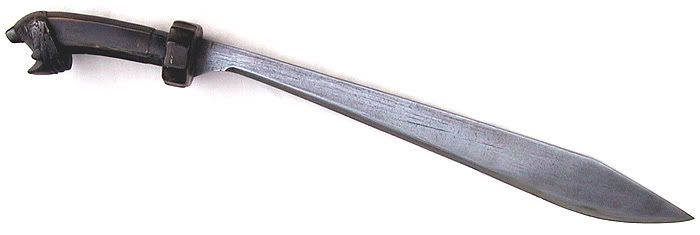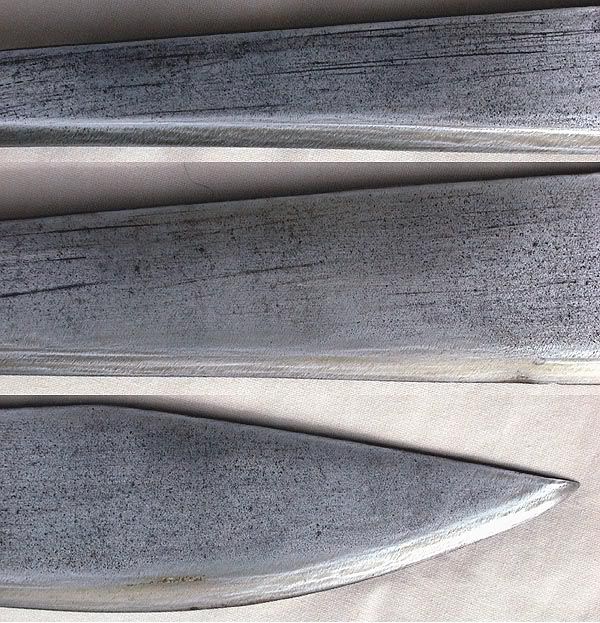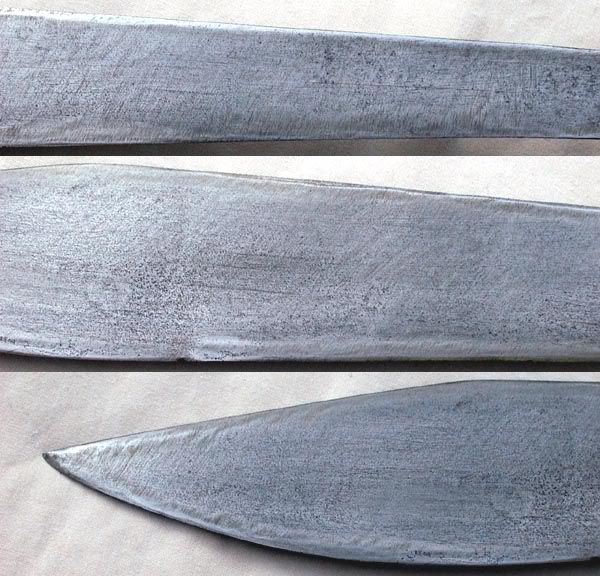
 |
|
|
#31 |
|
Vikingsword Staff
Join Date: Dec 2004
Location: The Aussie Bush
Posts: 4,512
|
Spunjer:
Hardened edges -- yes, very common. Laminated blades -- I haven't etched enough Visayan blades to answer how commonly they may be laminated, but my impression is that laminated (pattern-welded) blades are much less common than blades of homogenous steel with an inserted or tempered hardened edge. Zel probably has the best handle on this question. Ian. |
|
|

|
|
|
#32 |
|
Member
Join Date: Dec 2004
Location: Houston, TX, USA
Posts: 1,254
|
Traditional Visayan swords I've known are commonly lineal folded steel that has been welded for homogeneity and usually edge-hardened (occasionally spring tempered). Temper lines vary considerably, but stop at or often short of the unsharp shaft at the base of the blade. However, I have seen some (old) ones with inlaid/scarf-welded edges, and currently have a nice big talibon/garab that though I haven't etched it, and may well not, seems to exhibit such. So, yes, they are laminated, though it may depend on what you mean by laminated, and seems to vary with time, if nothing else.
|
|
|

|
|
|
#33 |
|
Vikingsword Staff
Join Date: Dec 2004
Location: The Aussie Bush
Posts: 4,512
|
Well put. That was what I was trying to say.
|
|
|

|
|
|
#34 |
|
Member
Join Date: Dec 2004
Location: Houston, TX, USA
Posts: 1,254
|
I'd love to know more, especially re the scarf welded edges; are they the older way, as we might expect? Are they seen on mandau? the scarf-welded chiselground blade, often with an overall wedge section is common on Japanese work knives, and I gather it was once seen on Japanese fighting swords, so there seems to be some sort of Oceanic E Asian thing going on (reference the tangs, too, BTW; and when one looks at spears and floormats and much other material culture along the interface of Asia and Pacific one sees a relation.........of course?); I have a feeling that this may be a thing that once was common in places where it modernly is not, but that's all I have; speculation and knowledge from swords and possibly from dimly remembered sailors' and/or collectors' tales re the ancestralness of the c-bevel and/or scarfed-edge blade............
|
|
|

|
|
|
#35 | |
|
Member
Join Date: Dec 2004
Location: Witness Protection Program
Posts: 1,730
|
Quote:
could you please elaborate more on this statement: "commonly lineal folded steel that has been welded for homogeneity and usually edge-hardened ". does that mean that if i etch a blade that has that characteristic, what i would get is a very dark edge, almost black, and the rest of the blade is gray, without those "topographic" lines?   
|
|
|
|

|
|
|
#36 |
|
Member
Join Date: Dec 2004
Location: Houston, TX, USA
Posts: 1,254
|
More or less. Steel that has been welded for homogeneity, basically simply folded steel, does exhibit layers, even if intially folded up from a single piece (which is not traditionally usual, but I think is seen with swords made from springs, for instance); the fire alters the alloy at the surface of the billet, so the dividing lines can be found, and of course you will see them where there are welding flaws etc, but A/ it will often take a lot of etching, and B/ what was B? Dang, there was B......B/fine layers will often appear as a small-grained lineal fibrousness, almost similar to the inside of rattan.
Moro swords, though less-so kris sundang, are often much like this, too, with a temper line, but the welding is done, for technological and/or aesthetic reasons, for contrast/difference; to leave layers of differing alloys which still retain their individual natures/alloys/properties, and that are easily seen from an etch. Other Moro blades I've seen have inlaid edges, or occasionally panelled construction (like Turkish or medieval German(nic) swords), and some such macro-lamination (with a crosswise temper line that's often visible only in the edge steel, the rest often being unhardenable) appears usual on old kris sundang. So there are two very seperable issues here; micro-lamination (ie. folding or patterning in the steel) which can be done for homogeneity or for contrast; and macro-lamination, which is the joining of larger pieces to form a blade, usually with the idea of using their various properties in appropriate areas, but occasionally for size. Typically the macro laminated SE Asian blade is made of micro laminated pieces, but not always, of course, especially the edge (bit) which is likely more often/earlier imported industrial steel than would be whole blades. Last edited by tom hyle; 30th April 2005 at 11:28 AM. |
|
|

|
|
|
#37 |
|
Member
Join Date: Dec 2004
Location: Houston, TX, USA
Posts: 1,254
|
Once I got a double temper line etching a Visayan sword and I don't know what to say about it. There is a narrow stripe at the edge that's dark, and then a wider stipe that's less dark, and then the paler "base" colour, if I may. Sometimes it's hard to tell weld lines from temper lines, but hese lines do not coincide with the grain of the metal.
|
|
|

|
|
|
#38 |
|
Vikingsword Staff
Join Date: Nov 2004
Posts: 6,376
|
I'd like to read your impressions on these construction methods :
Last edited by Rick; 30th April 2005 at 04:20 PM. |
|
|

|
|
|
#39 |
|
Vikingsword Staff
Join Date: Dec 2004
Location: The Aussie Bush
Posts: 4,512
|
Here is a Visayan sword that I posted a while back in another thread. The edge hardening is obvious after an etch with ferric chloride. What's your take on the method used here?
Last edited by Ian; 30th April 2005 at 06:10 PM. |
|
|

|
|
|
#40 |
|
Member
Join Date: Dec 2004
Location: Houston, TX, USA
Posts: 1,254
|
Photos are difficult to read compared to examining an object but I'll give a go. Rick, That kris sundang apears to be a sandwich type blade, which is usual. It is possible that it is panel-welded, but one does not often see that much wander to the core on panel welded swords, whereas it is fairly common to see in the side plates from forging out the tip on sandwich type blades (is it kind of helical, or does it go toward the same edge on both sides?). The cheeks of the blade seem to show some contrast internally/macro. The very central (widthwise speaking) area seems to perhaps have a more complex pattern of some kind, but is not clear in the photo? Is it humped, or hollowed? Does it show core or a sort of 5 layer constuction; I've seen kris sundang with 5 macro layers; didn't etch 'em, but it'd make sense if the outer one on the flats was a decorative one, and I don't think I've seen an old kris sundang (this is a kris sundang, yes?) with hollow ground flats, which might expose the core on a sandwich blade. Oop Yes I have, but only as a distinct groove; not the subtle hollowed flat. Looking some more. It looks like a more or less flattened hex cross section. Near the tip there's a small welding flaw within the pattern of the most outer macro layer (?), but I wouldn't worry too much about it.
The dog head sword looks to be displaying a temper line. It could be an inlaid edge, but seems to exhibit a jagged uneveness usually seen only from welds if they are for pattern, which is possible, but I don't think is what I'm seeing. Not at all sure though, and probably being influenced by my expectations. Close-up? The blade has some longwise lines that may be fold lines, but are more likely grindlines, and some cloudy shapes that are probably sheen/patination/etc? The close close up I can't see much in; I think I see an inlaid edge; I see some kind of layering, and only right at the edge. I'm not sure what to make of the dark area on the blunt (?) side of the tip. Ian, I see a temper line on the one you show. Note it is the same breadth on both sides; a macro weld on this type of blade is expected to be scarfed, so it is wide on the flat side, and narrow like this on the cutting bevel. I don't see any sign of folding, but it looks like an old sword to me, and it probably is folded steel with the other main likelihood being imported foreign industrial steel, but as I say, I suspect that was often folded as well, by PI smiths. Notice the temper line stops well short of the base of the blade. Last edited by tom hyle; 30th April 2005 at 06:01 PM. |
|
|

|
|
|
#41 |
|
Vikingsword Staff
Join Date: Dec 2004
Location: The Aussie Bush
Posts: 4,512
|
Tom:
I added some further pictures which do seem to show a laminated blade, as you suggested, and more detail of the hardened edge from each side. Does the prominent white line demarcating the hardened edge reflect a transition zone as a result of the tempering process? Ian. |
|
|

|
|
|
#42 |
|
Vikingsword Staff
Join Date: Nov 2004
Posts: 6,376
|
Hi Tom the central core ( I believe it goes all the way through) on the kris sundang is a very heavy jellyroll twist ; that area is also a wide shallow fuller , there is also a narrow deeper fuller on one edge .
The Bonifacio (if I may) seems to me to be cheeks of different steel laminated on a possibly iron core ; that blade has had a thorough etch ; only problem is if it is tripartate construction the lines of demarcation are not readily apparant on the spine . The last picture is of the Baiwan sword tip ; I believe this may well be the same construction method as the bolo . A better look at the bolo edge . And below it what I believe to be an inlaid panel over the core of a very old kris , akin to pamor . Last edited by Rick; 30th April 2005 at 08:14 PM. |
|
|

|
|
|
#43 |
|
Member
Join Date: Dec 2004
Location: Houston, TX, USA
Posts: 1,254
|
Yes, akin to pamor is a pretty good description of the usual kris sundang construction. What makes you think the one is panel-welded? I take it the core tracks the same way on both sides? An inlaid edge on a single edged blade that runs all thne way thru to the spine would be odd; more usually it is pinched into the edge of the blade.
|
|
|

|
|
|
#44 | |
|
Vikingsword Staff
Join Date: Nov 2004
Posts: 6,376
|
Quote:
The first kris sundang picture I posted I'm pretty sure that the core is spiral jellyroll pattern if you will all the way through and the laminated edge was forge welded on . The second older kris with the leaf like central pattern I believe to be applied to both sides of the sword in a fairly thin layer over the blade as you can see it fade out toward the point unlike the other sundang blade . Am I making any sense ? 
|
|
|
|

|
|
|
#45 |
|
Member
Join Date: Dec 2004
Location: Witness Protection Program
Posts: 1,730
|
...and i thank you, tom, for your time.
(psst, your message box is full  ) )
|
|
|

|
|
|
#46 |
|
Vikingsword Staff
Join Date: Dec 2004
Location: The Aussie Bush
Posts: 4,512
|
Dragged out this old one and etched it this afternoon to find evidence of lamination of the blade and a hardened edge similar to the binangon I showed above.
We know this one is old because it has an older style Visayan scabbard, a wooden disk guard that is asymmetrical, and the blade just looks "old." The beveled edge has been ground many times and shows clear lamination.    
|
|
|

|
|
|
#47 |
|
Member
Join Date: Dec 2004
Location: Houston, TX, USA
Posts: 1,254
|
I thank you, spunjer, for the pictures of a very nice looking old sword
 Rick, rather than try to further diagnose from a distance why don't you send me your swords? Just joking  Rather than try to further diagnose from a distance, I'll tell you a thing to look for. Look at the spine of the blade on the dog head sword, within the clip, at the very tip. If the surface is clean and etched well, and the hard steel goes all the way to the tip, you should either see the edge bit pinched in, or the hard part will end in a line that runs across the spine, perpendicular to the length of the sword (usually slanty, but only very slightly; nothing one would mistake for a scarf weld). Rather than try to further diagnose from a distance, I'll tell you a thing to look for. Look at the spine of the blade on the dog head sword, within the clip, at the very tip. If the surface is clean and etched well, and the hard steel goes all the way to the tip, you should either see the edge bit pinched in, or the hard part will end in a line that runs across the spine, perpendicular to the length of the sword (usually slanty, but only very slightly; nothing one would mistake for a scarf weld). Even in person, there is often no real visual cue to decide between a weld and a hardening line; logic concerning the shape of the line and its relation to any welded grain there may be are largely our tools. There is often a different look to a weld than a hardening line, but one cannot always rely on that in my experiece. Last edited by tom hyle; 1st May 2005 at 12:20 PM. |
|
|

|
|
|
#48 |
|
Member
Join Date: Dec 2004
Location: Witness Protection Program
Posts: 1,730
|
ian,
is that a bathead? better yet, and if you don't mind, can you post a "mugshot" of that baby? 
|
|
|

|
|
|
#49 | |
|
Vikingsword Staff
Join Date: Dec 2004
Location: The Aussie Bush
Posts: 4,512
|
Ron:
It's just a common variety of Panay demon/deity figure. Pictures are attached below. Ian. Quote:
|
|
|
|

|
|
|
#50 |
|
Member
Join Date: Dec 2004
Location: Witness Protection Program
Posts: 1,730
|
thanks ian. i don't think it's a common type, is it? it seems like it's one of those diety hilt that belongs in "Others" category. it's not your typical round head, rhino horn diety like this dude right here ===>

|
|
|

|
|
|
#51 |
|
Vikingsword Staff
Join Date: Dec 2004
Location: The Aussie Bush
Posts: 4,512
|
Spunjer:
You're right to ask how common this particular form of deity hilt might be. I really don't know if this style is common. What I meant to say was that it is a deity hilt of the Panay/Negros form, which is a common finding on these older Visayan tenegre. Ian. |
|
|

|
|
|
#52 |
|
Member
Join Date: Dec 2004
Location: Houston, TX, USA
Posts: 1,254
|
I think it's a version of a zoomorphic/deity pommel that is common (the nose horn guy; seen some dispute as to who he is...); this particular form of the stylization is not common to my experience, but the subject is not particularly unusual. There are at least 3 standardized stylizations that, at least to me, all seem to be this same guy.
|
|
|

|
|
|
#53 |
|
Member
Join Date: Feb 2005
Location: Clearwater, Florida
Posts: 371
|
"Guy"?
Once again, sexism rears its ugly head (no pun intended). Sorry, but I couldn't resist...while female deities/fetishes are sometimes prominent in African, Indian items and a few Indonesian pieces, I can't think of any in the Muslim tradition or those cultures closely associated with same. Mike |
|
|

|
|
|
#54 |
|
Member
Join Date: Dec 2004
Location: Houston, TX, USA
Posts: 1,254
|
These characters seem animistic and related to those used by other nearby peoples, and are probably pre-Islamic and pre-Christian in the area, I would think. Still, I've only heard any of these pommel deities referred to as male, and that could for all I know be a product of the observing culture, or of the observed. Hmmmm................
|
|
|

|
|
|
#55 |
|
Member
Join Date: Dec 2004
Location: Houston, TX, USA
Posts: 1,254
|
My garab definitely has a scarf-welded edge. ModernVisayan swords tend to be homogenous steel with a differential temper. Interesting thread found while searching for machete filipiana......
|
|
|

|
|
|
#56 | |
|
EAAF Staff
Join Date: Dec 2004
Location: Louisville, KY
Posts: 7,342
|
Quote:
|
|
|
|

|
 |
| Thread Tools | Search this Thread |
| Display Modes | |
|
|